Vietnamese cuisine places a strong emphasis on a rich variety of vegetables, which contribute diverse flavors and textures to its dishes. Now, let’s explore the world of “Vietnamese Vegetables” and understand their importance in Vietnamese cooking.
Contents
Vietnamese Vegetables and Environment
Vietnam’s geographical diversity is a valuable asset for its vibrant vegetable production. The country comprises three distinct mountainous regions, four coastal areas, and vast expanses of fertile rice fields within its unique S-shaped territory. This diverse landscape has given rise to seven distinct ecological regions, providing an ideal environment for cultivating a wide variety of vegetables.
With 3,260 kilometers of coastline stretching across 28 provinces and cities, Vietnam’s vegetable cultivation benefits from the rich mineral springs, elevated plateaus, and ancient forests that span from north to south. This unique topography grants Vietnam the exceptional advantage of producing a wide range of vegetables, from tropical and subtropical to temperate varieties.
Vietnam’s fertile soil further contributes to its vegetable diversity. The country’s soil is exceptionally rich and varied, creating favorable conditions for agricultural and horticultural endeavors. This fertile ground supports a diverse flora, boasting approximately 14,600 plant species. In particular, the lush tropical jungles that thrive in Vietnam are home to plants that thrive in well-lit environments with high temperatures and humidity.

Exploring the Rich Variety of Vietnamese Vegetables
Vietnamese cuisine is celebrated worldwide for its exquisite flavors and the diverse range of ingredients that contribute to its unique taste.
Flower Vegetables
Flower vegetables are a striking feature of Vietnamese culinary culture, prized for their visual appeal and delightful flavors. These delicate blooms are often used in vibrant salads and quick stir-fry dishes.
- Bap Chuoi (Banana Flower): Bap Chuoi, or banana flower, boasts a mild, nutty flavor and a crisp texture. Its subtle taste complements a variety of dressings. It is a star ingredient in “Goi Hoa Chuoi,” a refreshing banana flower salad. It is also served with hot pot dishes and hot soups.
- Hoa Thien Ly (Daylily Flowers): Hoa Thien Ly, or daylily flowers, are prized for their tender, slightly sweet petals. They bring a touch of elegance to dishes. Commonly featured in soups and stir-fries, these edible blossoms elevate the visual appeal of dishes.
- Hoa Bi Ngoi (Sesbania Flowers): Hoa Bi Ngoi, or sesbania flowers, are known for their soft, delicate petals and subtle, earthy flavor. They are used in a variety of dishes, including salads and soups, and are appreciated for their mild taste and tender texture.
- Cai Xanh (Chinese Broccoli): Cai Xanh, or Chinese broccoli, is characterized by its thick, crunchy stems and lush, dark green leaves. Often featured in soup and stir-fry dishes, cai xanh provides a delightful contrast in texture and a mild, leafy flavor.
Leafy Vegetables
Leafy vegetables hold a special place in Vietnamese cuisine, often finding their way into nourishing soups and broths. These greens provide not only flavor but also essential nutrients to traditional Vietnamese dishes.
- Rau Muong (Morning Glory): Rau Muong, or Morning Glory, is known for its vibrant green leaves and hollow stems. It has a slightly peppery taste. A staple in “Canh Chua,” a sour tamarind soup, and “Bun Rieu,” a crab noodle soup, rau muong adds a refreshing crunch to soups.
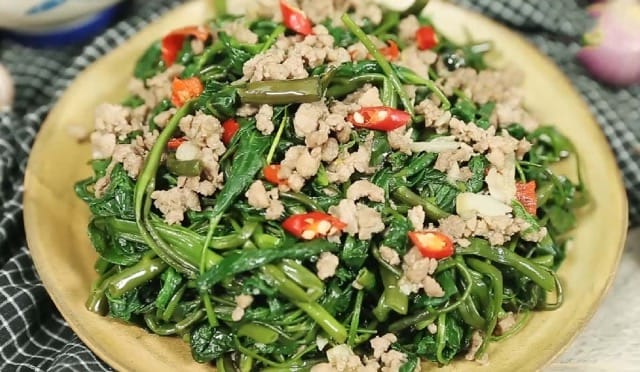
Stir-fried Morning Glory Vegetable With Garlic Is A Must-Try Dish – Source: Internet
- Rau Mong Toi (Malabar Spinach): Rau Mong Toi, or Malabar spinach, a vigorous climbing vine, can grow up to 10 meters in length. Its heart-shaped, green leaves are a distinctive feature. It is commonly used in Vietnamese cuisine, often featured in soups and stir-fried dishes with garlic for a unique culinary experience. However, it’s worth noting that Malabar spinach can become slimy when cooked, which may not appeal to everyone’s palate.
- Rau Den (Amaranth): Amaranth, a versatile leafy vegetable, comes in two primary varieties: white and crimson. When cooked, both types exhibit a remarkable transformation as the water takes on the vibrant crimson hue of the leaves. In Vietnamese cuisine, amaranth often takes center stage in various soup dishes, such as shrimp and crab soups, becoming a staple in most meals.

Amaranth Has Red-Purple Color and Tastes A Bit Sweet – Source: Internet
- Cải thìa (Bok Choy): Bok choy, known as “cải thìa” in Vietnamese, is a popular leafy green vegetable widely used in Vietnamese cuisine. Its tender stalks and dark green leaves are favored for stir-fries, soups, and hot pots. Bok choy adds a delightful crunch and mild, slightly sweet flavor to dishes, making it a versatile and nutritious vegetable in Vietnamese cooking.
- Katuk (Rau ngót): Katuk, often referred to as “rau ngót” in Vietnamese, is a lesser-known but cherished leafy green vegetable in Vietnamese cuisine. Its taste is tender, oval-shaped leaves and mild, slightly nutty flavor. Katuk is typically used in soups, stir-fries, and salads. Rich in vitamins and nutrients, it’s a nutritious addition to Vietnamese dishes, offering both flavor and health benefits.
Discovering vegan Vietnamese food to have great experiences.
Root Vegetables
Vietnamese cuisine boasts a variety of root vegetables that are not only delicious but also intriguing in their appearance and taste. These root vegetables add an exotic touch to Vietnamese dishes.
- Cu Den (Beetroot): Vietnam’s vibrant “củ dền” or beetroot has found favor in Vietnamese cuisine for its striking color, unique flavor, and nutritional benefits. Whether enjoyed raw in salads, where it provides a delightful crunch and visual appeal, or cooked through methods like roasting, boiling, or steaming, beetroot enhances dishes with its earthy sweetness. It adds depth to soups, complements stews, and can stand alone as a colorful side dish, making it a versatile ingredient cherished by both traditional and modern Vietnamese cooks.
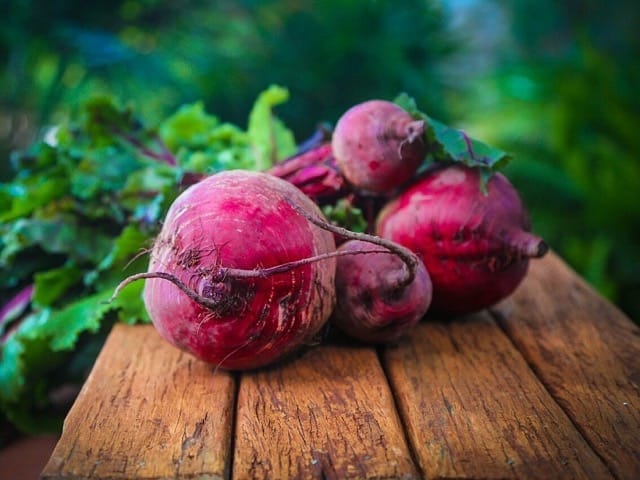
Source: Internet
- Sắn (Cassava): Cassava, known as “sắn” in Vietnamese, is a staple root vegetable in Vietnamese cuisine. Cassava is valued for its starchy texture and is a key ingredient in many traditional Vietnamese dishes. It’s used in various forms, such as cassava chips, cassava cake, and cassava noodles.Khoai Lang (Sweet Potatoes)
- Khoai Lang (Sweet Potato): Khoai Lang, or sweet potatoes, come in various colors and textures, from creamy white to vibrant orange. Whether roasted, mashed, or used in desserts, khoai lang is a versatile ingredient that adds sweetness and a comforting earthiness to dishes.
- Cu Khoai Mon (Taro Stems): Cu Khoai Mon, or taro stems, have a starchy, slightly nutty taste and a fibrous texture. Often found in traditional dishes like “Canh Khoai Mon” (taro stem soup) and stir-fries, they provide a hearty and satisfying element.
Fruit Vegetables
Fruit vegetables in Vietnamese cuisine bring a delightful fusion of sweetness and savory flavors to the table. They are commonly used in both savory and sweet dishes, adding a unique dimension to Vietnamese delicacies.
- Kho Qua (Bitter Melon): Kho Qua, or bitter melon, is notable for its oblong shape, warty skin, and intensely bitter taste. While known for its bitterness, it is used in “Canh Kho Qua” (bitter melon soup) and stuffed bitter melon dishes, offering a unique flavor profile.
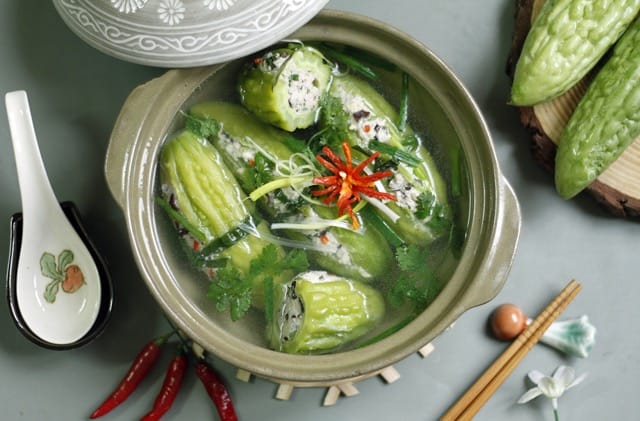
Kho Qua Soup Is usually used In Tet With The Mean Of Good Luck – Source: Internet
- Bí Ngô (Pumpkin): Pumpkin, referred to as “bí ngô,” serves as a versatile vegetable. Its sweet and nutty flavor complements both savory and sweet preparations. Pumpkin is used in soups, stir-fries, and desserts, adding a delightful richness to Vietnamese cuisine.
- Mướp Hương (Sponge Gourd): The unique texture of mature sponge gourd, when peeled and sliced, resembles a sponge, and it’s often used as a natural scrubber or bath accessory in addition to being a delightful ingredient in various dishes. Its tender flesh and mild flavor make it a popular choice for stir-fries, soups, and curries.
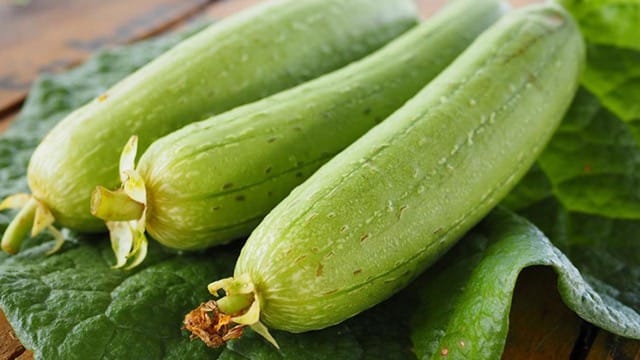
Sponge Gourd Has Tender Flesh And Mild Flavor – Source: Internet
Vietnamese Herbs and Spices
Vietnamese cuisine is celebrated for its rich tapestry of flavors, and at the core of this culinary tapestry lie a variety of herbs and spices that lend their distinctiveness to each dish.
- Vietnamese Mint (Rau Răm): Vietnamese mint, known as “rau răm,” imparts a refreshing and slightly peppery taste with citrus undertones. This aromatic herb is a fundamental ingredient in Vietnamese cuisine, frequently incorporated into salads, spring rolls, and soups. Its vibrant and invigorating notes enhance the flavors of many vegetable-based dishes.
- Lemongrass (Sả): Lemongrass, or “sả,” contributes a lively, citrusy aroma with a mild, lemon-like flavor. This herb is a prominent feature of Vietnamese cooking, particularly in stir-fried and soup-based recipes. Its aromatic essence elevates vegetable-based dishes, imparting a delightful fragrance.
- Thai Basil (Húng Quế): Thai basil, or “húng quế,” offers a sweet and slightly spicy taste, reminiscent of anise and cloves. Thai basil plays a pivotal role in numerous Vietnamese dishes, including stir-fries and noodle preparations. Its unique flavor complements vegetables, creating a harmonious blend of tastes.
- Cilantro (Ngò rí): Cilantro, known as “ngò rí,” delivers a fresh, citrusy flavor with subtle earthy notes. Cilantro is a versatile herb employed in a wide range of Vietnamese vegetable-based recipes. Its vibrant taste adds complexity to salads, soups, and marinades.
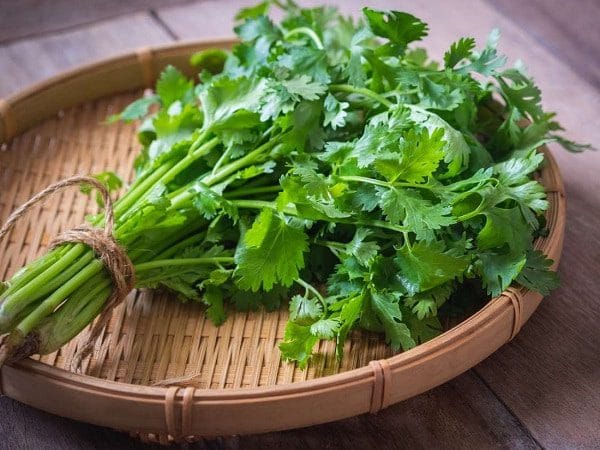
Cilantro Is Added To Hot Soup To Enhance The Flavor- Source: Internet
- Star Anise (Hoa Hồi): Star anise, or “hoa hồi,” boasts a robust, sweet, and licorice-like flavor. Frequently found in vegetable-based broths and soups, star anise imparts a unique and warming flavor that enhances the depth of Vietnamese culinary creations.
- Turmeric (Nghệ): Turmeric, or “nghệ,” exhibits an earthy, slightly bitter taste alongside its vivid yellow hue. Turmeric is often utilized to season vegetables and create aromatic curry dishes. Its flavor and color contribute richness to vegetable-based recipes.
- Ginger (Gừng): Ginger, or “gừng,” possesses a spicy, mildly sweet taste with a pungent aroma. Ginger serves as a versatile spice in Vietnamese stir-fries and soups. Its aromatic and warming qualities complement a variety of vegetable-based preparations.
- Garlic (Tỏi): Garlic, or “tỏi,” provides a pungent, savory taste with a fragrant aroma. A fundamental component of Vietnamese cuisine, garlic imparts flavor to vegetable stir-fries, sauces, and marinades, enhancing their overall taste.
- Chili Peppers (Ớt): Chili peppers, or “ớt,” offer a range of spiciness, from mild to fiery hot. Chili peppers introduce heat and depth to vegetable-based dishes, infusing them with a spicy kick, a signature characteristic of Vietnamese cuisine.Food Markets and Shopping: An Authentic Exploration.
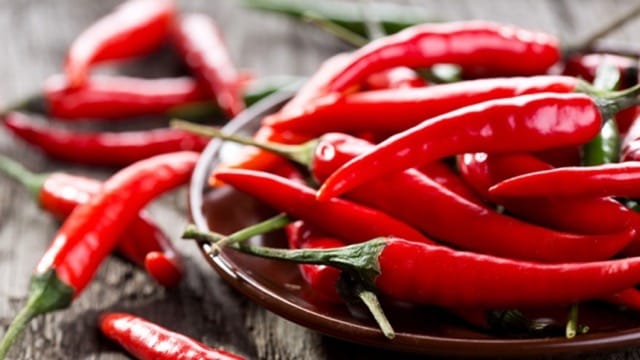
Chili peppers spice up Vietnamese vegetable dishes, adding a signature fiery kick – Source: Internet
Where To Buy Fresh Vegetables?
- Local Markets: To truly immerse yourself in the authentic culinary culture of Vietnam, there’s no better way than to explore the local markets. Whether you’re wandering through the bustling streets of Hanoi, the charming corners of Hoi An, or the vibrant markets of Saigon, each region offers a unique array of produce. These markets are a kaleidoscope of colors and textures, from crisp greens to exotic root vegetables. Interacting with local vendors here is not just a transaction; it’s a chance to connect with the vibrant culture and traditions of Vietnam.
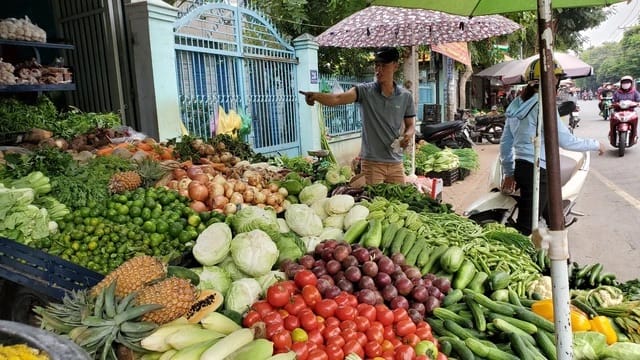
You Can Buy Vietnamese Vegetables In Every Market – Source: Internet - Grocery Stores: For a more convenient shopping experience, Vietnam has a growing number of well-stocked grocery stores, ranging from local markets to international chains. These stores provide a wide selection of fresh vegetables, catering to the preferences of both locals and expatriates. Alongside familiar favorites like tomatoes, cucumbers, and bell peppers, you’ll also discover more unusual finds such as water spinach and taro stems. Shopping at these stores offers the convenience of a modern setting while still allowing you to explore the diverse world of Vietnamese vegetables.
You can try Banh Cam (Vietnamese Sesame Ball) – one of 30 best fried food in the world.
Health and Nutrition: A Bounty of Wellness
Vietnamese vegetables are not only culinary delights but also nutritional powerhouses. Here are some key points that will interest health-conscious travelers:
- Low-Calorie, High-Nutrient: Vietnamese vegetables are typically low in calories but brimming with essential nutrients such as vitamins, minerals, and dietary fiber. This makes them an excellent choice for those aiming to maintain a balanced diet while enjoying local cuisine.
- Freshness and Flavor: The vegetables available in Vietnamese markets and stores are often harvested daily or procured from nearby farms. This freshness not only enhances their flavor but also ensures you reap the maximum nutritional benefits from your meals.
- A Rich Tapestry of Tastes: Vietnamese vegetables offer an extensive range of flavors, colors, and textures. From the crispy crunch of cucumbers in “Gỏi Cuốn” (spring rolls) to the earthy sweetness of sweet potato leaves in “Cánh Măng” (bamboo shoot soup), there’s a vegetable to suit every palate.
- Abundance of Antioxidants: Certain Vietnamese vegetables like glory morning (known locally as “Rau Muống”) and Vietnamese mint (“Rau Răm”) are rich in antioxidants, crucial for overall health and protection against various diseases.
- Digestive Health Support: Many Vietnamese vegetables are high in dietary fiber, aiding digestion and promoting gut health. Ingredients like bitter melon leaves (“Rau Diếp Cá”) are particularly valued for their digestive benefits.
- Hydration and Vitality: Vegetables like cucumber and water spinach have high water content, helping to keep you hydrated in Vietnam’s tropical climate. Staying well-hydrated is essential for overall well-being as you explore the country.
Conclusion
Vietnamese vegetables bring diverse flavors and nutrition. Explore these vibrant ingredients to delve into Vietnamese culture and enrich your culinary skills. Dive into the world of “Vietnamese Vegetables” to enhance your cooking experiences.
Frequently Asked Questions
1. How can I make Vietnamese pickled vegetables at home?
Making Vietnamese pickled vegetables is easy and delightful. Here’s a step-by-step guide:
- Ingredients:
- Cabbage, Carrot and Daikon Radish
- Vinegar (rice vinegar is preferred)
- Sugar
- Salt
- Water
- Steps:
- Wash and peel the vegetables. Cut them into thin, uniform strips or slices.
- In a saucepan, combine equal parts vinegar and water, then add sugar and salt to taste. Heat until the sugar and salt dissolve, and the solution cools.
- Place the vegetables in a clean, dry glass jar.
- Pour the vinegar mixture over the vegetables, ensuring they are fully submerged.
- Seal the jar and let it sit at room temperature for at least 24 hours for the flavors to meld.
Serve them as a side with pho, banh mi, or grilled meats like bun cha. They provide a refreshing crunch and tangy contrast that complements the savory flavors of Vietnamese cuisine. Experiment with different combinations to find your favorite pairings.
2. How to make Vietnamese vegetable soup recipe?
- Ingredients:
- Leafy vegetables or tubers (options include Malabar spinach, kale, cabbage, cauliflower, squash, gourd, carrots, radishes, potatoes, etc.)
- Protein of your choice (shrimp, beef, pork, eggs, sausages, or bones)
- Green onions
- 1 purple onion (optional for added fragrance)
- Knor seasoning powder
- Salt
- Sugar
- MSG
- Pepper
- Cooking oil
- Filtered water (about 1 liter when using bones)
- Instructions:
- Prepare the vegetables and tubers by cleaning and cutting them into bite-sized pieces. Smaller and thinner tubers cook faster. Cut the meat into bite-sized pieces after washing.
- If you prefer a more fragrant soup, chop an additional purple onion and fry it until fragrant before cooking. If you want a quicker or less oily soup, you can skip this step.
- Fry the onions until fragrant.
- Pour in water (about 1 liter for bone-based soup), and bring it to a boil.
- Once boiling, add the meat.
- IMMEDIATELY season the soup with the following ratios: 1 tablespoon of Knor seasoning powder, 1 tablespoon of sugar, 1/5 tablespoon of MSG, and 1/3 teaspoon of salt.
- As the water boils, it may create foam. Use a spoon to skim off the foam to keep the soup clear. After removing the foam, use a separate clean spoon to taste the soup. Avoid tasting directly with the cooking spoon to maintain hygiene.
- Once the soup tastes okay, add the prepared vegetables and green onions. Turn off the stove when the vegetables are cooked. Sprinkle in pepper to enhance the warmth of the soup.
3. How to say vegetables in Vietnamese?
In Vietnamese, the word for vegetables is “rau”.
4. Where to buy Vietnamese pickled vegetables?
You can find ready-made Vietnamese pickled vegetables at local markets, specialty stores, and even some grocery stores. Local markets offer a wide variety, while specialty stores often provide artisanal options with distinct flavors. Enjoy these delicious condiments at your convenience.


Related Posts
Saigon’s “Flower Market Replica”: Where To Find Them
Ho Chi Minh City’s floral charm is not limited to its bustling wholesale markets. Imagine wandering through a place where vibrant petals, fragrant blooms, and the spirit of traditional Vietnamese markets come alive—without the overwhelming crowds. A flower market replica captures that magic, blending the beauty of fresh flowers with the charm of a curated, […]
Is it Safe to Travel to Vietnam Right Now? A Complete 2025 Guide
Vietnam has emerged as one of Southeast Asia’s most captivating destinations, drawing millions of visitors annually with its rich culture, stunning landscapes, and incredible cuisine. However, many travelers still ask: Is it safe to travel to Vietnam right now? This comprehensive guide provides you with everything you need to know about Vietnam travel safety in […]
Ho Chi Minh Cu Chi Tunnels Tour: The Ultimate Guide
The Cu Chi Tunnels stand as one of Vietnam’s most remarkable historical sites, offering visitors a profound glimpse into the ingenuity and resilience displayed during the Vietnam War. For travelers, a Ho Chi Minh Cu Chi tunnels tour represents an essential experience that combines education, adventure, and deep cultural understanding. This comprehensive guide will help […]